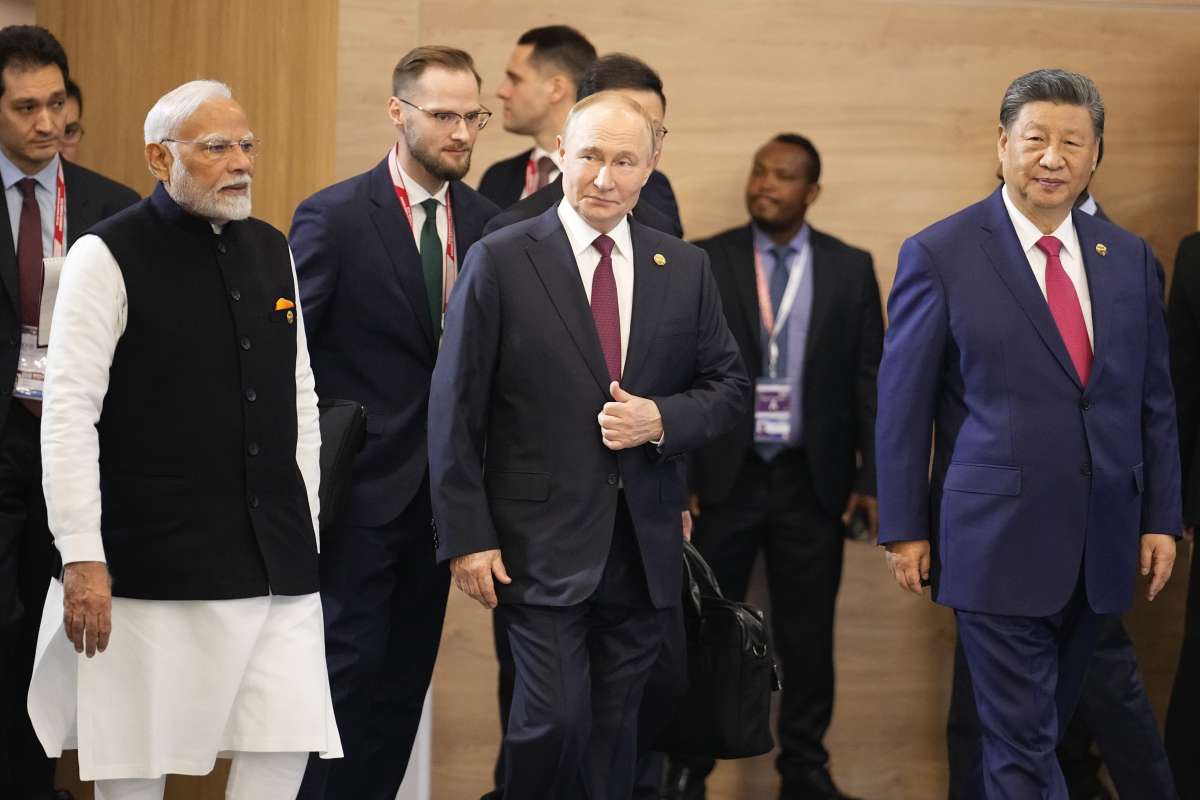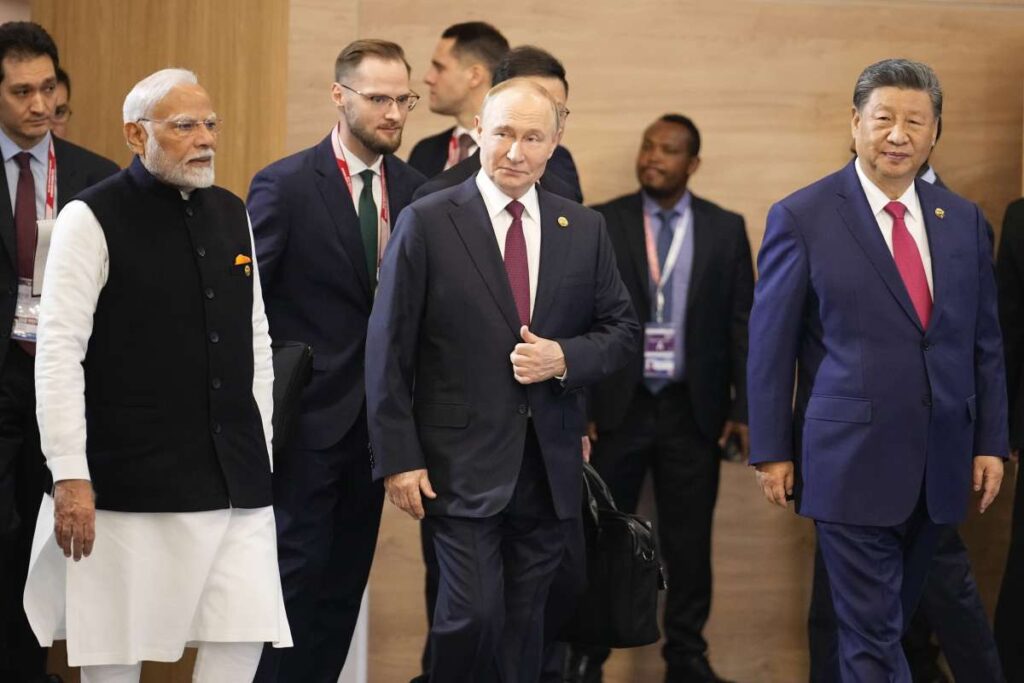

The one-hour meeting between the Indian Prime Minister Narendra Modi and the Chinese President Xi Jinping on October 23 on the side lines of the BRICS summit at Kazan, has signalled a breakthrough in the bilateral relations between the two largest nations of Asia and the world. What was of significance of the latest meeting was the cordial optics and the mood of the two leaders who gave definite indications of going ahead with the task of restoring normal relations based on cooperation and competition.
The stage was set with the agreement on the disengagement of the troops of both sides on the controversial Galwan area. This was a matter of satisfaction for the Indian side, but the more important was the desire to go ahead with the discussions on the border issue on which an understanding was reached. India’s National Security Adviser Ajit Doval will be meeting soon his Chinese counterpart to broach the issue in its totality.
The border dispute issue has been the bane of bilateral relations between India and China since 1959; it led into a full scale war in 1962, and then in the last six decades few clashes took place including the bloody one at Galwan in 2020. But the real issue of the conflict between India and China is related to the changing perception about India’ foreign policy amongst the Chinese political leadership. Once this perception changes and becomes favourable, the developments will follow in positive direction in the bilateral relationship between the two neighbours.
If we begin from the first years of the India-China relationship in 1950’s, the first phase was the era of Hindi-Chini Bhai Bhai in 1954 and afterwards; then suddenly Mao Zhe Dong called Jawaharlal Nehru as an ally of imperialists in 1960’s, wanted to teach India a lesson and 1962 followed. During this Mao period, China took anti-India position, and even in 1971 India-Pakistan war, took a pro-Pak stand, without getting involved in the war. Mao died in 1976 and after Deng Xiao Ping’s takeover, it was a period of only pursuit of growth and development in China. The India issue went into the background. The border dispute remained in the same state, excepting few occasional small skirmishes till Galwan clashes in 2020.
In the last ten years since Narendra Modi took over in 2014 as the Prime Minister of the BJP-led government, there has been a perceptible shift in the India’s foreign policy. India has distanced itself from the developing countries, including not taking part actively in the SCO and the BRICS, and becoming a part of the four-member QUAD, which China thinks as the security bloc led by the USA to confront China in Asia-Pacific. This latest perception about India becoming more and more getting aligned with US interests has clouded China’s understanding.
There is another factor. Despite being a nation led by the Communist Party, the Chinese in general have a deep nationalistic pride. Now after emerging as the second largest economy in the world and by surpassing the USA in some key areas of technology, Chinese leadership wants to reshape the Global South away from narrow US interests. Now India and China nearly match in population, though Indian GDP and the per capita income is far less compared to China. China does not take India as a peer competitor. While economists talk of the 21st century as an Asian century led by China and India, Chinese leaders term the 21st century as effectively China’s century.
But there is a catch. Despite all the high GDP and per capital income growth by China compared to India, Chinese leaders are aware that India is growing fast, despite its inequality on the basis of a vibrant democracy. The elections are like carnivals for the Indian citizens including the poorest. This is an issue which keeps the leadership uneasy when they compare India with China.
President Xi Jinping is a product of Deng Xiao Ping period. He along with his politburo colleagues have considered a number of times some measures for democratisation of the Chinese society in the last twelve years he is at the helm as the general secretary of the Chinese Communist Party, but finally, nothing could be done. On the other hand, India is racing fast to emerge as the third largest economy after the US and China by certainly 2030, if not by 2027. China cannot ignore this competitor with the advantage of more demographic dividend and the sharing of the same history of ancient civilisation that is more than five thousand years old.
At a personal level, Xi Jinping and Narendra Modi are of same generation. Modi was born in 1950 three years after the Indian independence and Xi Jinping in 1953, four years after China’s communist takeover took place on October 1, 1949. Both are tech-savvy. Xi Jinping’s daughter Xi Mingze, now 32, studied at Harvard University from 2010 to 2014.Xi gets information about the new generation through her. He follows each and every development in USA in high-tech sector including the semiconductor chips, and guides the Chinese technologists and scientists to compete with them. He has a modern mind. Similarly despite his Hindutva obsessions, Narendra Modi is tech-friendly, and has also a mind of quick adaptation as far as technology is concerned. Both these modern minds can meet.
After the Kazan meet, as a follow-up, while the Doval-Wang boundary talks are very important, measures should also be taken to bring in FDI investment in areas required by India. The Indian government can certainly look at security aspects but there are a large number of areas where the Chinese investment can be sought without attracting security concerns. This step is needed since FDI inflows to India has dwindled in the last two years and one of the reasons is India has failed to allow global chain system of China in the country which would have led to investment by more foreign companies.
For India, growing tension between India-China limited the scope for foreign investors in China to diversify to India under China+1 strategy. Investment by USA is a case in point. USA was the second biggest foreign investor in India in 2020-21. It was US$ 13,823 million. It plunged to US $ 4998 million in 2023-24 – a drop by over 63 percent. In contrast, USA investment in ASEAN surged by over 112 percent in 2023 over 2021, Presumably, this demonstrates that US investors in China preferred to shift to ASEAN than in India under China+1 strategy. This is high time, India takes advantage of China+1 strategy to boost foreign inflows into India.
BRICS meet discussed the issue of de-dollarization and how the process is moving.. BRICS members including China also know, that this is a long process, but it has to continue. Significantly, Prime Minister Modi said that he was in favour of an alternative payment system for the BRICS members. This is a major support to de-dollarization and this has been highly welcomed by both China and Russia.
Xi Jinping’s assertion for more communication and cooperation between the two countries was notable in the present era of bilateral relations. China’s top leaders generally tell politically correct remarks in public but that is not always followed by actions. This time when the year is ending, Chinese President has a chance to implement in action what he said at Kazan at the BRICS meeting. As regards Narendra Modi, he has to prove that he can really exercise strategic autonomy vis-a-vis USA as the upcoming third largest economy of the world. USA needs India more than India needs USA in view of India’s burgeoning domestic market.
A follow-up of the positive signals from the BRICS summit at Kazan can be carried forward by the Indian Prime Minister at the G-20 summit in Brazil in the third week of November this year. India has to take the lead in ventilating the grievances of the Global South, along with Brazil and Mexico who are best examples of following strong independent foreign policy, keeping good relations with both USA and China on their terms.. By distancing itself from QUAD and refusing to be a part of USA’s anti-China Asia-Pacific strategy in a calibrated manner, India can emerge as the leader of Global South by restoring its old position. That may lead to a better era in India-China relations and ensure peace and stability in Asia-Pacific also. For Narendra Modi, that is a big challenge. Will he be daring to accept it in the weeks ahead? (IPA Service)




